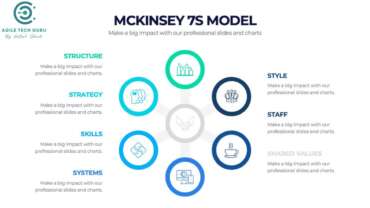Vatsal Shah
Certified ScrumMaster® | Agile Technical Project Manager
Unlock Business Growth with the McKinsey 7S Model: A Comprehensive Guide

In the business world, achieving consistent success is a challenge most organizations face. With 9 out of 10 businesses failing to meet their goals, one question arises:What sets the top-performing 10% apart?The answer lies in adopting a proven framework that aligns all aspects of an organization. One such framework is the McKinsey 7S Model, a timeless tool designed to optimize internal operations and boost organizational performance.Whether you’re a small business or a multinational corporation, the McKinsey 7S Model can help you align strategy, culture, and structure to foster long-term success.
What is the McKinsey 7S Model?
The McKinsey 7S Model was developed in the late 1970s by Tom Peters and Robert Waterman, two consultants at McKinsey & Company. The model identifies seven critical factors that must work together seamlessly for an organization to be successful.These seven elements are divided into two categories:
- Hard Elements: Strategy, Structure, and Systems.
- Soft Elements: Shared Values, Style, Staff, and Skills.
The model emphasizes that these elements are interconnected. A change in one element will affect the others, making alignment essential for success.

The 7 Elements of the McKinsey 7S Model
Let’s take a closer look at the seven elements and how they contribute to organizational success:
1) Strategy
The strategy is the blueprint for achieving your organization’s goals. It outlines your long-term objectives, competitive advantage, and how you plan to adapt to market changes.
- Key Questions to Ask:
- Does your strategy align with your mission and vision?
- Are you leveraging market opportunities effectively?
2) Structure
Structure refers to the way your organization is organized, from hierarchy to departmental roles. A well-defined structure ensures clarity in responsibilities and decision-making.
- Key Questions to Ask:
- Is your organizational structure supporting your strategy?
- Are reporting lines clear and effective?
3) Systems
These are the processes and workflows used to accomplish day-to-day tasks. Efficient systems ensure that operations run smoothly and consistently.
- Key Questions to Ask:
- Are your systems optimized for productivity?
- Are there any bottlenecks in your processes?
4) Skills
Skills include the competencies and expertise your organization needs to succeed. This applies not just to individuals but to the organization as a whole.
- Key Questions to Ask:
- Does your team have the skills needed to execute the strategy?
- Are you investing in training and development?
5) Staff
The people in your organization, their roles, and how they are managed are key to your success. This element focuses on talent acquisition, development, and retention.
- Key Questions to Ask:
- Do you have the right people in the right roles?
- Is your workforce engaged and motivated?
6) Style
Style refers to the leadership approach, management practices, and overall organizational culture. It sets the tone for how decisions are made and how employees interact.
- Key Questions to Ask:
- Does your leadership style foster collaboration and innovation?
- Is your culture aligned with your organizational goals?
7) Shared Values
At the core of the 7S Model are the shared values that define your organization’s identity. These values influence behavior and decision-making across all levels.
- Key Questions to Ask:
- Are your shared values clearly defined and communicated?
- Do they align with your long-term vision?
Hard vs. Soft Elements: Understanding the Balance
The McKinsey 7S Model divides elements into two categories:
- Hard Elements:
These are tangible and measurable, such as strategy, structure, and systems. They are easier to define and implement. - Soft Elements:
These are intangible and focus on people and culture, such as shared values, style, staff, and skills. While harder to measure, they are critical for fostering collaboration and innovation.
For an organization to thrive, both hard and soft elements must be in alignment.
How to Apply the McKinsey 7S Model
Here’s a step-by-step guide to implementing the 7S Model:
- Identify the Seven Elements
Map out each element within your organization. - Evaluate the Current State
Assess the effectiveness of each element. Identify strengths and weaknesses. - Spot Misalignments
Look for inconsistencies between the elements. For example, does your structure support your strategy? - Develop Action Plans
Create a roadmap to address gaps and align the elements. - Implement Changes
Roll out the changes across your organization, starting with high-priority areas. - Monitor Progress
Continuously track progress and refine your approach as needed.
Why the McKinsey 7S Model Works
The 7S Model is not just another business framework; it’s a holistic approach to organizational alignment. By addressing both tangible and intangible factors, it ensures that every part of your organization works harmoniously toward shared goals.This model is particularly valuable during times of change, such as mergers, restructuring, or strategy shifts. It provides a clear framework for navigating complexities and ensuring cohesion.
Conclusion: Is Your Organization Aligned for Success?
In today’s fast-paced business environment, the key to success lies in alignment. The McKinsey 7S Model offers a proven framework for aligning strategy, structure, and culture to achieve your goals.By focusing on both hard and soft elements, you can build a resilient organization that adapts to change and drives long-term growth.
